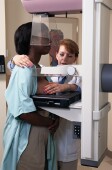
THURSDAY, Nov. 19 (HealthDay News) — Responding to the uproar over revised mammogram recommendations unveiled earlier this week, a member of the independent task force that crafted the recommendations defended them Thursday, saying they were based on the most current, accurate information available.
Dr. Timothy Wilt, a member of the U.S. Preventive Services Task Force, defended the recommendation that most women don’t need to get mammograms in their 40s and should get one every two years starting at age 50. That recommendation runs counter to the American Cancer Society’s long-held stance that women should get a yearly mammogram starting at age 40.
The task force’s recommendations “were based on the most rigorous peer review of up-to-date, accurate information about the evidence about the harms and benefits of treatment,” Wilt said on ABC’s Good Morning America, the Associated Press reported.
On Wednesday, U.S. Health and Human Services Secretary Kathleen Sebelius responded to the controversy that followed the release of the task force recommendations on Monday. She said the USPSTF does “not set federal policy and they don’t determine what services are covered by the federal government.”
Sebelius added that American women should “keep doing what you’ve been doing for years — talk to your doctor about your individual history, ask questions, and make the decision that is right for you.”
She also said she’d be “very surprised if any private insurance company changed its mammography coverage decisions as a result of this action.”
Wilt did not take issue with Sebelius’ statement. “Our recommendations support an individualized decision-making process,” he said, and each woman still needs to talk with her doctor to make the most informed decision, the AP reported.
In reaching its recommendations, the task force of doctors and scientists determined that early and frequent mammograms often lead to false-positive readings and unnecessary biopsies, without substantially improving the odds of survival for women under 50.
Reaction to the proposed guidelines has been swift.
Critics such as the American Cancer Society vowed to stand by its advice that annual screening begin at age 40 for women of average risk. The American College of Radiology agreed.
But what will doctors who see female patients day after day suggest they do?
The guidelines recommend that women aged 40 to 49 and at average risk for breast cancer talk to their doctor about when it would be best for them to begin mammography screening. Those aged 50 to 74 should have every-other-year screenings, rather than an annual mammogram, according to the new guidelines. As for women aged 75 and older, the task force concluded that there is not enough evidence to assess the benefits and harms of the test.
Whether they agree or disagree with the guidelines, experts seem to agree that women should talk to their health-care providers for guidance based on their individual medical history and other factors.
Three such providers — an internist, a family physician and a gynecologist — weigh in on what they will advise their patients to do.
An Internist’s View
“The evidence supports the recommendation,” said Dr. Karla Kerlikowske, director of the Women Veteran’s Comprehensive Health Center at the San Francisco Veterans Affairs Medical Center, who wrote an editorial accompanying publication of the guidelines in the Annals of Internal Medicine.
“I think for women 40 to 49, we should target women who are at high risk,” she said, such as those with a first-degree relative with breast cancer.
Changing the screening interval from annually to every two years for women 50 to 74, she said, “is one of the best things they did.” At her clinic, Kerlikowske said, biennial screening has been a standard for years.
A Gynecologist’s View
Gynecologist Judi Chervenak, an associate clinical professor of obstetrics-gynecology and women’s health at Montefiore Medical Center and Albert Einstein College of Medicine in New York City, said she will tell her patients this: “From age 39 on, a woman should have a yearly visit to her health-care provider, during which she discusses which routine tests are appropriate for her, including mammography.”
But, she also said she favors mammography for many women.
“Unless the patient is at increased risk of radiation exposure or increased mental health stress of dealing with a false-positive test, I still feel that the use of the mammogram is a potentially lifesaving and quality-of-life improving test for many women,” Chervenak said.
“We know that mammography often picks up a cancer before it can be palpated,” she said. “We have to do everything we can to maintain our quality of life.”
A Family Physician’s View
A woman should remember that the guidelines are based on the entire population and that her own decision must be an individual one, said Dr. David Baron, a family physician and chief of staff at Santa Monica-UCLA Medical Center and Orthopaedic Hospital in Santa Monica, Calif., and an assistant clinical professor of family medicine at the David Geffen School of Medicine at the University of California, Los Angeles.
“That’s why communication between a patient and her health-care professional is very important,” Baron said.
The new guidelines, in his view, are encouraging physicians to individualize the screenings.
“Some of this will depend on how risk-adverse a woman is,” Baron said. A 40-year-old woman, for instance, might be afraid of radiation from a mammogram and be at average risk for breast cancer. No matter how much a doctor explains that the radiation amount is minimal, he said, she might not be convinced, and she might be advised to wait.
On the other hand, he said, another 40-year-old woman might be very frightened of breast cancer and want the screening. For her, Baron said, he might advise sticking with annual screening.
To women 50 and up, Baron said he would say: “I think it’s important to have a mammogram. Whether you want to have it every year or every two years is negotiable.”
And for his patients 75 and older? “It’s really a matter of individual choice,” he said.
The task force has drawn criticism for recommending fewer mammograms and starting them later. But Baron offered another perspective. “I respect them a great deal,” he said. “They’ve got no horse in the race. They are independent experts.”
He said the task force did its best to sort through the available evidence and come up with the most scientifically sound guidelines.
Women should also realize that the results of future studies might change the recommendations yet again, Baron said. And no matter what the recommendations are, he said, women must always discuss their own medical history and risks with their doctors when making a decision about screening for breast cancer or any other disease.
The best advice, according to Baron: Know the guidelines. Know your risk. Decide with your health-care professional the best screening schedule for you.
More information
The American Cancer Society has more on mammography.

